Original title: The State of Crypto Lending
Original author: Zack Pokorny, researcher at Galaxy Digital
Original translation: Aiying compliance
The "Current Status of Cryptocurrency Lending" summarized by Galaxy Research on April 14, 2025 is the full text of the report: Lending is an application scenario of cryptocurrency, and a strong market fit has been found on and off-chain. At the peak of the entire market, the scale of the lending market exceeded US$64 billion. The lending market plays an important role in building a financial ecosystem based on digital assets, allowing users to acquire the liquidity of their holding assets through lending, so as to deploy in decentralized finance (DeFi), or trade on on-chain and off-chain platforms.
This report explores the on-chain and off-chain cryptocurrency lending market, which is divided into two parts: the first reviews the history of the crypto lending market, market participants, historical scale (including on-chain and off-chain), and some critical moments in the field. The second part deeply analyzes the operating mechanisms of some lending products and other sources of leverage in both on-chain and off-chain environments, who are using these products, and the risks of each product. This report presents the full picture of the crypto lending market, revealing the most widely used but opaque area of the crypto economy. Most importantly, the report provides a rare perspective on the size of the off-chain lending market, a historically relatively opaque part of the crypto industry.
1. Key Conclusion
The overall size of the crypto lending market remains significantly lower than the peak of the crypto bull market in 2020-2021. As of the fourth quarter of 2024, the crypto lending market, including crypto-secured debt positions (CDP) stablecoins, was $36.5 billion, down 43% from the all-time high of $64.4 billion set in the fourth quarter of 2021. This decline can be attributed to the collapse of lenders on the supply side and the shrinking of funds, individuals and businesses on the demand side.
As of the fourth quarter of 2024, the total size of the crypto lending market was US$36.5 billion, and the top three centralized financial (CeFi) lending institutions include Tether, Galaxy and Ledn. The loan book size of these three companies reached US$9.9 billion at the end of the fourth quarter of 2024, accounting for 88.6% of the CeFi lending market (Tether accounts for about 73% of the proportion reached 8.2 billion), and the market size mainly constitutes:
· Centralized Finance (CeFi) lending: US$11.2 billion,
· Decentralized Finance (DeFi) lending: US$19.1 billion
Crypto Asset-Backed Collateral Debt Position (CDP) Stablecoin: US$6.2 billion
On-chain lending applications have experienced strong growth since the crypto market bear market trough in the fourth quarter of 2022 (on-chain lending size is $1.8 billion). As of the fourth quarter of 2024, the total amount of open borrowing on 20 lending applications and 12 blockchains was $19.1 billion. This means that DeFi borrowings have increased by 959% over the eight quarters.
2. Market Overview
The provision of crypto lending services mainly uses two channels: decentralized finance (DeFi) and centralized finance (CeFi). Both have their own unique characteristics and products provided. Here is a brief overview of CeFi and DeFi lending services:
1. Centralized Finance (CeFi)
CeFi is a lending service for cryptocurrencies and related assets provided by centralized off-chain financial companies. Some CeFi entities use on-chain infrastructure, or their entire business is built on the chain. CeFi lending can be roughly divided into three categories:
a. OTC
OTC transactions are provided by centralized institutions, providing a range of customized lending solutions and products. OTC transactions are bilateral transactions that allow personalized agreements between borrowers and lenders, with borrowing conditions including interest rates, term and loan value ratio (LTV). These products are usually only for qualified investors and institutions.
b. Main brokerage business
The main brokerage business platform provides guaranteed financial funds, transaction execution and custody services. Users can withdraw guaranteed financial funds from the main broker for use elsewhere, or for trading activities on the platform. Main brokers typically offer only limited financing of crypto assets and crypto ETFs.
c. Private credit on-chain
Allow users to gather funds on the chain and deploy them through off-chain protocols and accounts. Under this model, the underlying blockchain actually becomes a crowdfunding and accounting platform to meet off-chain credit needs. Debts are usually tokenized as secured debt positions (CDP) stablecoins or directly through tokens representing the share of the debt pool. Funding is usually narrow.
2. Decentralized Finance (DeFi)
DeFi is a smart contract-powered application that runs on the blockchain, allowing users to borrow money in cryptocurrency, lend money to earn income, or use leverage when trading. DeFi lending and borrowing have the following distinctive features: Operating 24/7, offering a wide range of borrowable and collateralized assets, and being completely transparent, allowing anyone to audit. Lending applications, secured debt position stablecoins and decentralized trading platforms all allow users to obtain leverage on the chain.
a. Lending and Loaning Application
These on-chain applications allow users to deposit collateral assets such as Bitcoin and Ethereum to borrow other cryptocurrencies. The loan conditions are pre-set by the application through risk assessment and are adjusted based on the mortgaged assets and borrowed assets provided by the user. On-chain lending and borrowing are similar to traditional over-mortgage lending.
b. Secured debt position stablecoin
These stablecoins are over-collateralized on individual cryptocurrencies or a basket of cryptocurrencies. The principle is similar to over-collateralized loans and borrowings, but the collateral deposited by users will issue synthetic assets.
c. Decentralized trading platform
Some decentralized trading platforms allow users to acquire leverage to amplify trading positions. Despite the different functions of the decentralized trading platform, the role of providing leverage is similar to that of CeFi master brokers. Leveraged funds are usually unable to be transferred from decentralized trading platforms, but their role is similar to CeFi's financing services.
3. Market development and history
The following diagram shows the major historical players in the CeFi and DeFi crypto lending markets. In 2022 and 2023, with the decline in crypto asset prices and the depletion of market liquidity, many of the largest CeFi lending platforms collapsed, especially Genesis, Celsius Network, BlockFi and Voyager filed for bankruptcy in the past two years. This has resulted in an estimated 78% shrinkage of CeFi and DeFi lending markets between the peak of 2022 to the low of bear markets, with open borrowings from CeFi lending down by 82%. The following sections will dive into the historical evolution and scale of the crypto lending market.
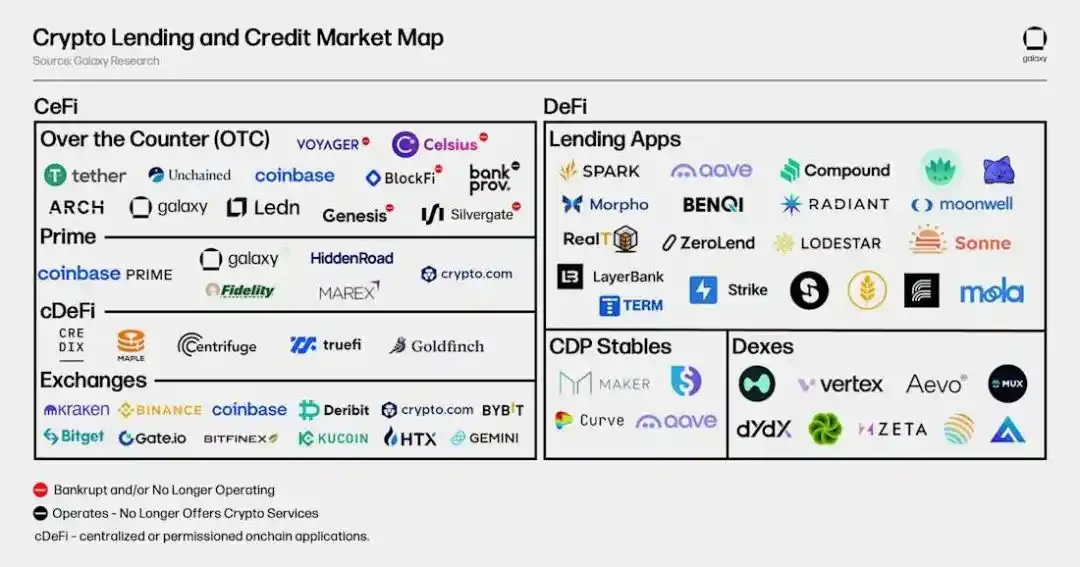
The following table compares some of the largest CeFi crypto lending institutions in history. The companies listed in some of the list provide multiple services to investors, such as Coinbase, which, while operating primarily as a cryptocurrency trading platform, provides credit services to investors through over-the-counter trading (OTC) cryptocurrency loans and guaranteed financial funds.
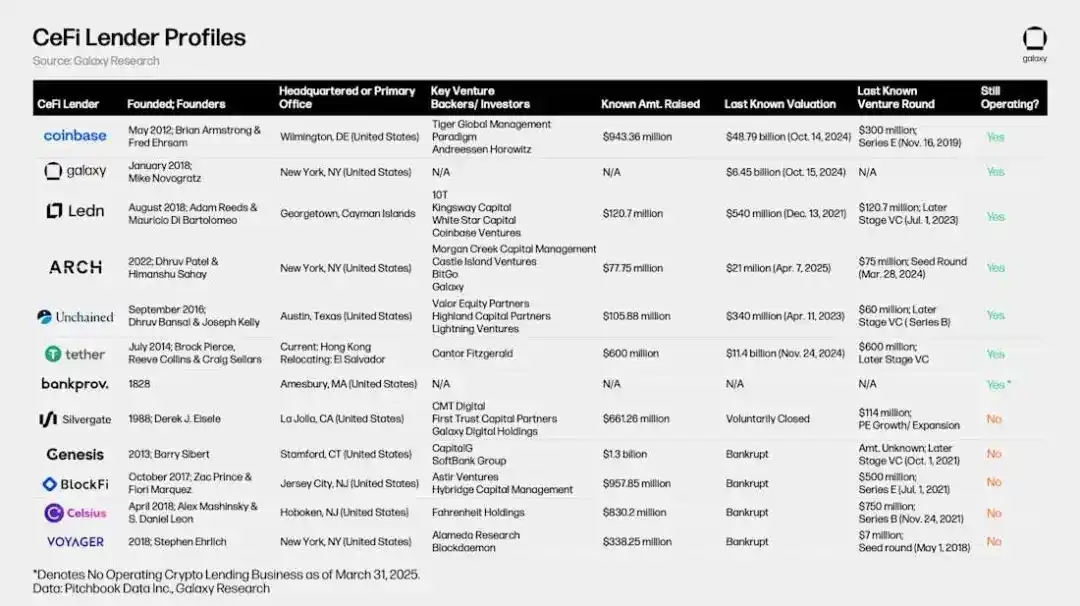
4. The history of crypto lending
Although on-chain and off-chain crypto lending did not begin to be widely used until late 2019/early 2020, some current and historically important players were established as early as 2012. It is worth noting that Genesis was founded in 2013 and its loan book size once reached US$14.6 billion. On-chain lending and CDP stablecoin giants like Aave, Sky (formerly MakerDAO) and Compound Finance were launched on the Ethereum platform between 2017 and 2018 respectively. The emergence of these on-chain lending/borrowing solutions is due to the emergence of Ethereum and its smart contracts, which were officially launched in July 2015.
The end of the crypto bull market in 2020-2021 marks the beginning of a turbulent 18-month period during which the market is plagued by bankruptcies. Several major events that happened at this time include: Terra's stablecoin UST, which eventually became worthless with LUNA; the decoupling of stETH, the largest liquid pledged token (LST), and the Grayscale Bitcoin Trust (GBTC) began trading at discounts below the net asset value (NAV) after years of premium trading.
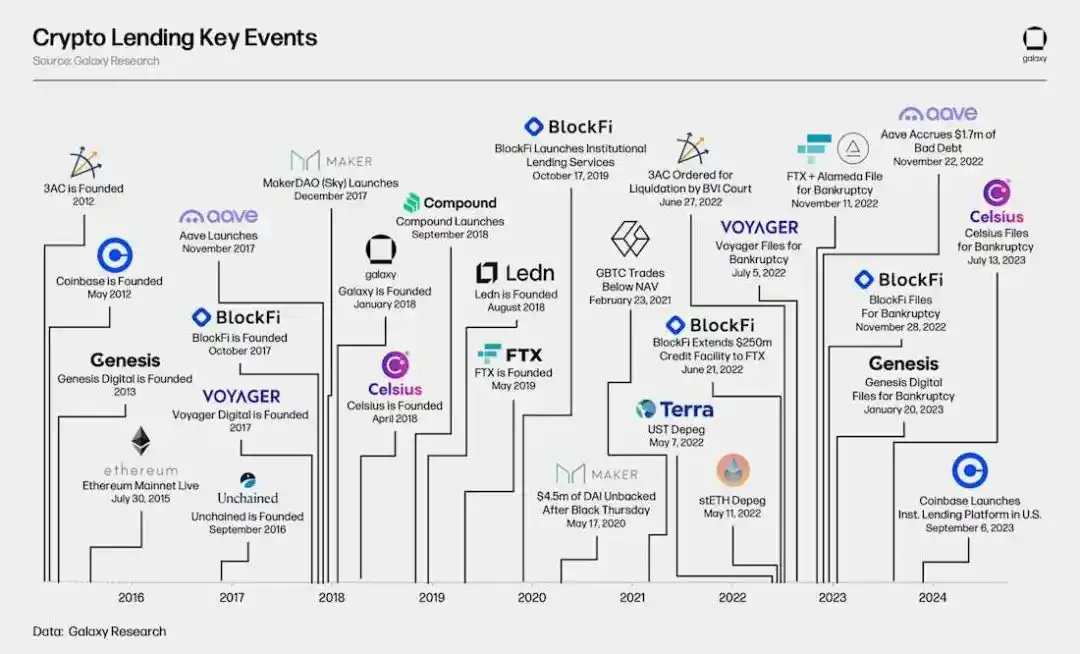
5. Market size
The overall size of the DeFi and CeFi crypto lending markets remains significantly below the peak level in the first quarter of 2022 (whichever quarter end data). This phenomenon stems mainly from the weak recovery of the CeFi lending market after the bear market in 2022 and the collapse of the largest lenders and borrowers in the market. The following analysis looks at the size of the crypto lending market from the perspective of CeFi and on-chain platforms.
At the peak of the market, Galaxy Research estimated that the total loan book size of CeFi lending platforms with access to data was $34.8 billion; while at the lows, the CeFi lending market size fell to $6.4 billion (down 82%). As of the end of the fourth quarter of 2024, the total size of the CeFi lending market was $11.2 billion, down 68% from its all-time high, but up 73% from its bear market trough.
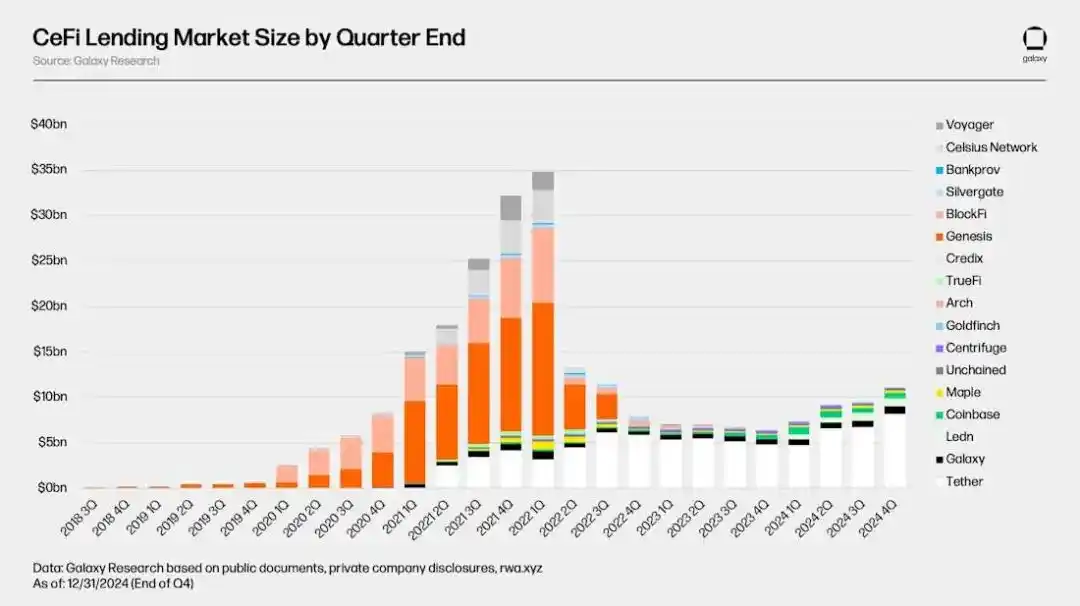
As the CeFi lending market shrinks over the past three years, the number of outstanding loans has been concentrated on smaller lending platforms. During the peak of the CeFi lending market in the first quarter of 2022, the top three lending platforms (Genesis, BlockFi and Celsius) accounted for 76% of the market, holding a total of $26.4 billion in loans of $34.8 billion. Today, the top three lending platforms (Tether, Galaxy and Ledn) still maintain 89% market share. From the above chart, we can see that Tether accounts for about 73%.
When evaluating the market dominance of one lending platform compared to another, it is important to note the difference between each platform, because not all CeFi lending platforms are the same. Some platforms offer only certain types of loans (e.g., Bitcoin-guaranteed loans, altcoin-guaranteed products, and cash loans that do not include stablecoins), serve only specific types of customers (e.g., institutional and retail customers), and operate only in specific jurisdictions. It is the combination of these factors that enable some lending platforms to scale on a larger scale than others.
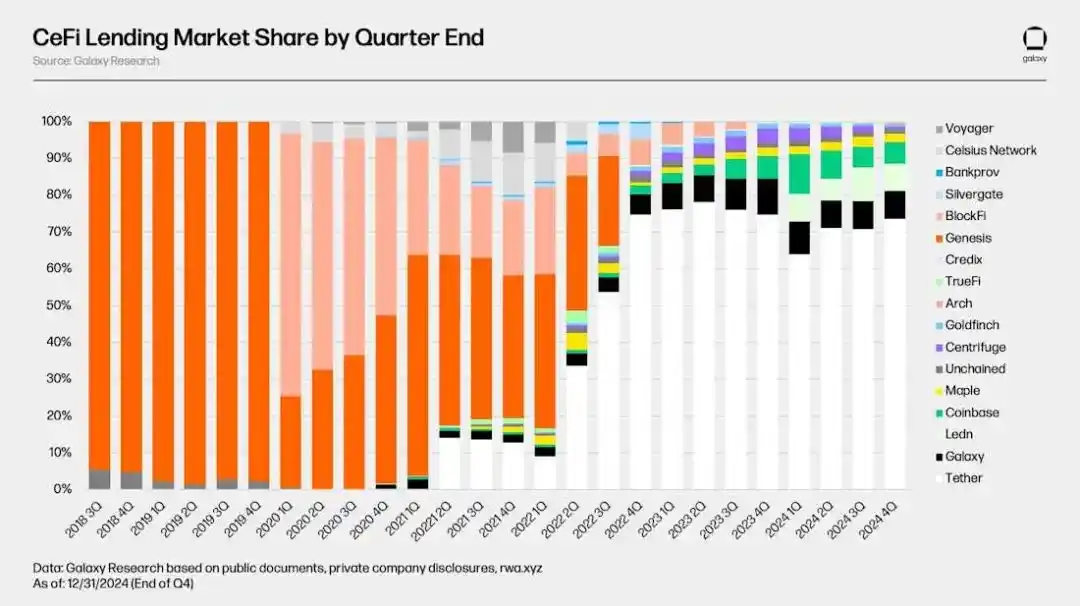
As shown in the chart below, on-chain applications such as Aave and Compound achieved strong growth through DeFi lending, rebounding from bear market lows of $1.8 billion to the end of the fourth quarter of 2024, with total outstanding borrowings on 20 lending applications and 12 blockchains reaching $19.1 billion. This is compared to the bottom, DeFi lending has increased by 959% over the past eight quarters. As of the end of the fourth quarter of 2024, the total outstanding loans for on-chain lending applications increased by 18% from the all-time high of $1.62 billion set in the 2020-2021 bull market.
DeFi lending recovers faster than CeFi lending. This can be attributed to the permissionless nature of blockchain-based applications and the fact that DeFi lending applications survived amid a bear market turmoil, while many of the large CeFi lending platforms declared bankruptcy and ceased operations. Unlike those large CeFi lending platforms that went bankrupt and ceased operations, many DeFi lending applications and markets have not been forced to close and continue to operate. This fact demonstrates the advantages of design and risk management practices of large-scale on-chain lending applications, as well as algorithmic, over-guarantee and supply-demand-based lending models.
After excluding CDP stablecoin market capital, the crypto lending market reached a peak of $4.84 billion in the fourth quarter of 2021. This market hit a low of $960 million in the fourth quarter of 2022, down 80% from its peak. Since then, the total market size has expanded to $3.02 billion, driven primarily by the expansion of DeFi lending applications, up 214% from its all-time low in the fourth quarter of 2024.
It should be noted that there is a potential duplicate calculation problem between the book size of CeFi loans and DeFi loans. This is because some CeFi platforms rely on DeFi lending applications to provide loan services to off-chain customers. For example, suppose a CeFi platform may use idle bitcoins to borrow USDC on the chain and then lend the same USDC to off-chain customers. In this case, the on-chain loans of the CeFi platform will appear at the same time in the outstanding loans of DeFi and will also appear in the financial statements of the platform as outstanding loans of its customers. Filtering such duplicate calculations is very difficult due to the lack of clear annotation of disclosure and on-chain attribution.
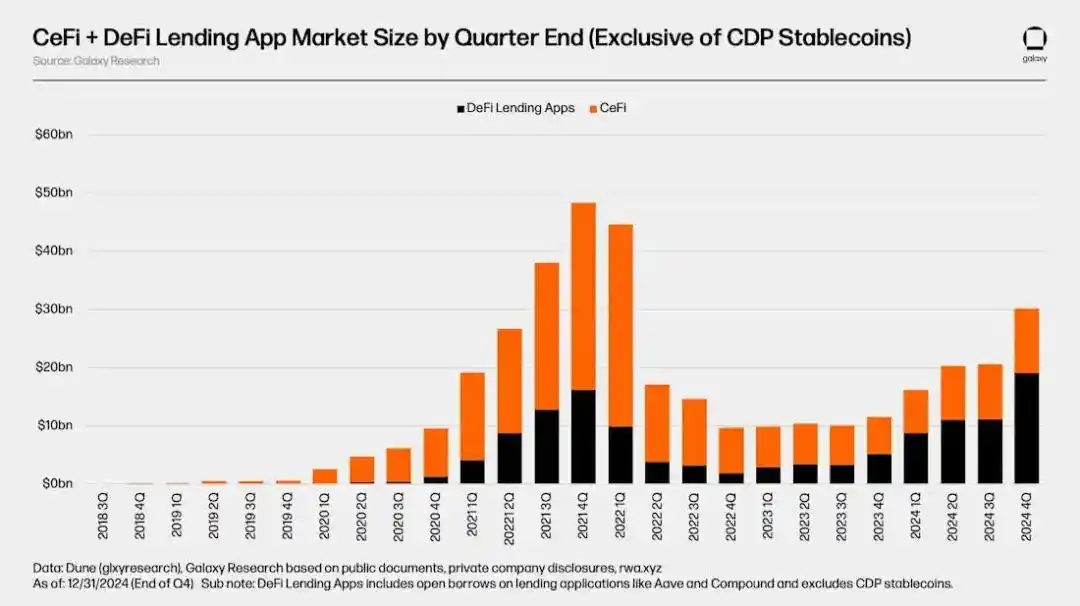
A notable change in the crypto lending market is that DeFi lending applications show a stronger dominance in bear markets than CeFi platforms and continue to expand as the market recovers. During the 2020-2021 bull market cycle, when excluding market capital of cryptocurrency-secured CDP stablecoins, DeFi lending applications accounted for only 34% of the total cryptocurrency borrowing; while as of the fourth quarter of 2024, the market share of DeFi lending applications has risen to 63%, almost twice its original share.

After the CDP stablecoin market capital included crypto-guaranteed CDP, the total size of the entire crypto lending market exceeded US$6.44 billion in the fourth quarter of 2021. At the bottom of the bear market in the third quarter of 2023, the market size was only US$1.42 billion, down 78% from the bull market peak. As of the fourth quarter of 2024, the market has rebounded 157% from its lows in the third quarter of 2023 to a total of $3.65 billion.
It should be noted that similar to borrowing through the DeFi lending application, there may also be duplicate calculation issues between the book size of CeFi loans and the supply of CDP stablecoins. This is because some CeFi entities rely on minting CDP stablecoins through cryptocurrency guaranteed to provide borrowing services to off-chain customers.
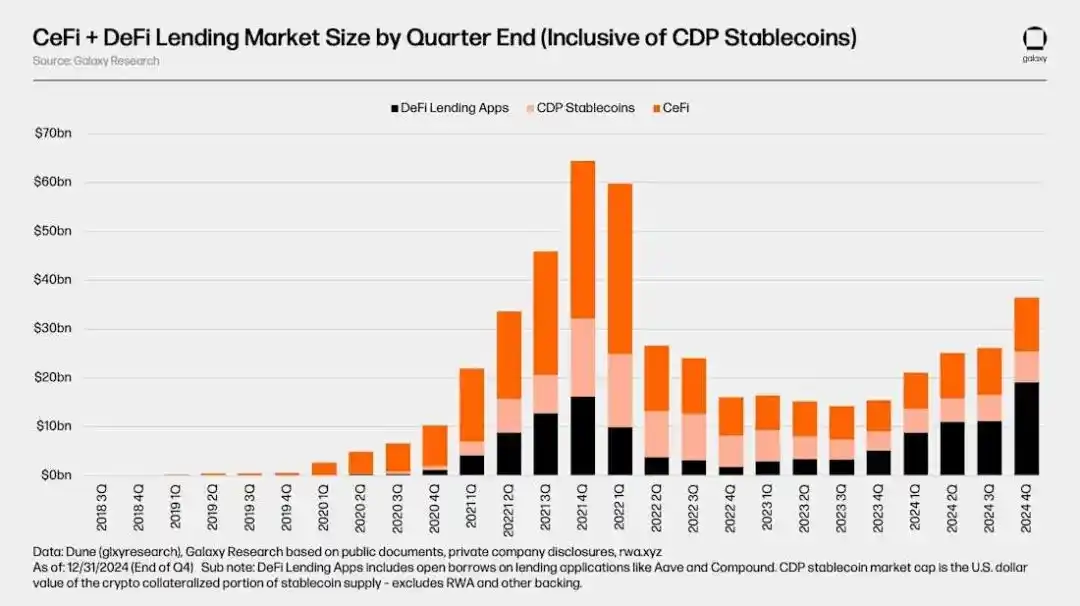
When CDP stablecoins that include crypto-guaranteed CDP, a significant increase in on-chain lending and borrowing market share can be observed. As of the fourth quarter of 2024, DeFi lending applications and CDP stablecoins accounted for 69% of the entire market. Its share has been on a steady growth trend since the fourth quarter of 2022. A noteworthy phenomenon is that the dominance of CDP stablecoins as crypto-guaranteed leverage is gradually declining. This can be attributed in part to the increase in stablecoins liquidity, improvements in borrowing and lending application parameters, and the introduction of neutral stablecoins like Ethena.
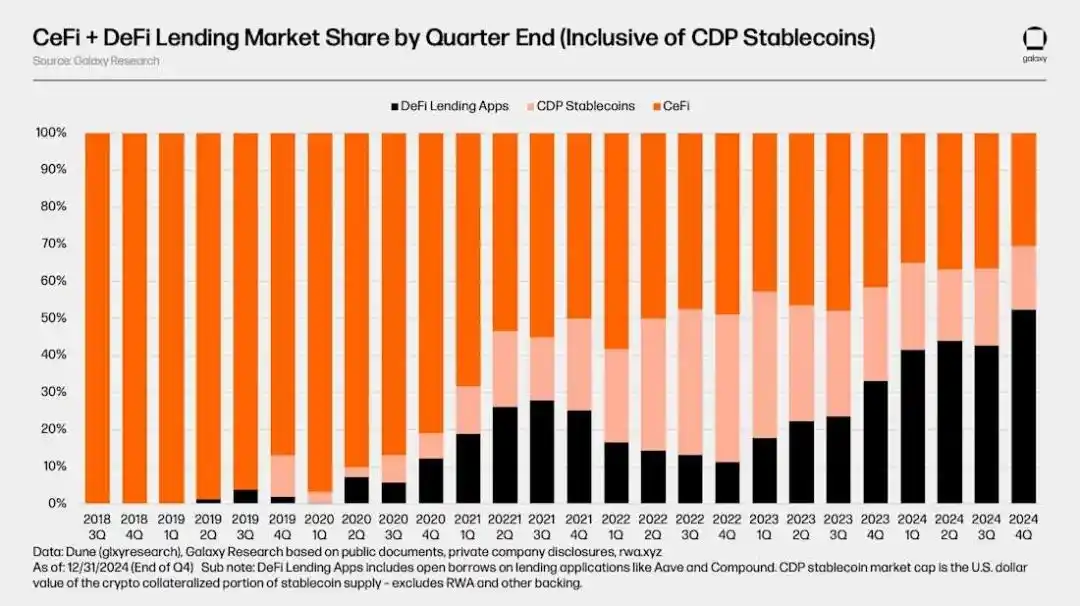
6. Market data logic and source
The following table shows the sources and logic used to compile the above-mentioned DeFi and CeFi lending market data. Although DeFi and cDeFi data can be retrieved through on-chain data, which is transparent and easy to obtain, the acquisition of CeFi data is more complex and has poor availability. This is due to the inconsistency of CeFi lending platforms when recording outstanding loans, the frequency differences in their disclosure of information, and the general difficulty in obtaining information.
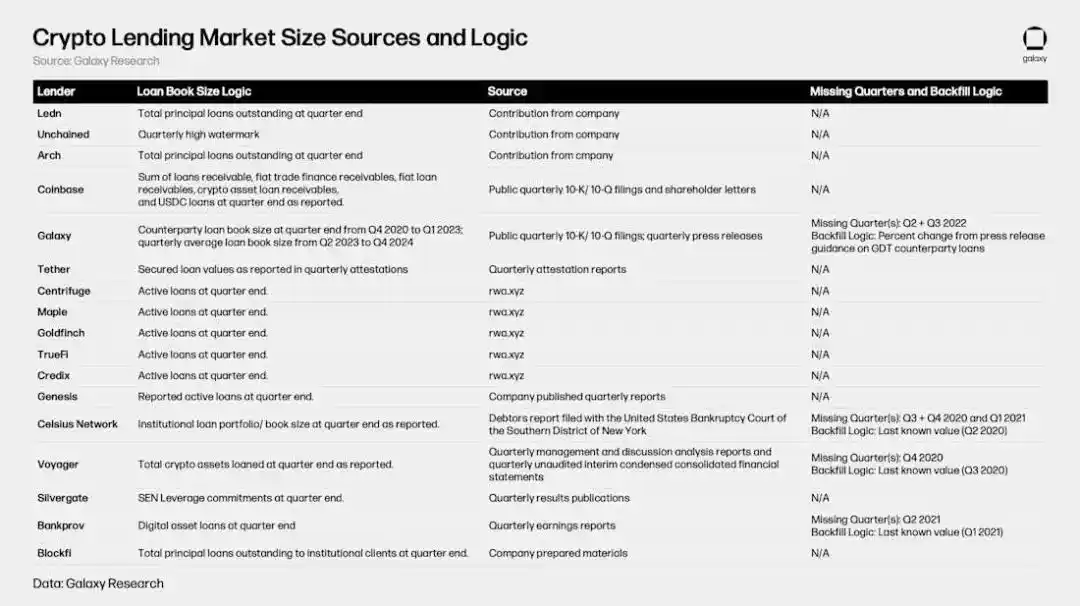
7. Venture Capital and Crypto Lending
CeFi and DeFi lending/credit application platforms raised a total of $1.63 billion through 89 transactions, which occurred between the first quarter of 2022 and the fourth quarter of 2024. Of these transactions, the most capital raised in the second quarter of 2022, with eight deals raising a total of at least $502 million. The fourth quarter of 2023 was the lowest, with total raised only $2.2 million.

For crypto economies, venture capital investment in lending and credit applications accounts for only a small part of the total investment. From the first quarter of 2022 to the fourth quarter of 2024, lending and credit applications accounted for only 2.8% of venture capital per quarter. Lending and credit applications accounted for 9.75% of total quarterly funds in the fourth quarter of 2022, the largest share; while in the most recent fourth quarter of 2024, the share was only 0.62%.

8. Historical review and future prospects of the crypto lending market
The root of the problem
The core reasons for the collapse of the crypto lending market in 2022-2023 include:
1. Asset prices plummeted:
In addition to Bitcoin and mainstream stablecoins, the total market value of crypto has shrunk by 77% (about $1.3 trillion), and the Terra ecosystem (UST and LUNA) evaporated $57.7 billion. The collateral value plummeted, and liquidity exhaustion led to debt defaults.
2. Toxic collateral:
stETH and GBTC: Due to the inability to redeem the underlying assets, poor liquidity lead to a sharp discount transaction (stETH discount of 6.25%, GBTC discount of 48.9%). Collateral for mining machines: The price of Bitcoin fell and the difficulty of mining increased, mining machine revenue decreased by 86%, and the value shrank by 85-91%, and some mining machines could not be disposed of.
3. Risk management failure:
Liquidity mismatch: CeFi platforms lend for a long time but rely on short-term funds, and cannot cope with runs when the market crashes. Unsecured loans are flooded: BlockFi offers unsecured loans to FTX, such as Celsius 36.6% loans. Lack of risk control: lack of standardized risk assessment, lax loan review, and risk-free limits for some platforms.
9. Future trends
1. Institutionalization of CeFi lending:
Traditional financial institutions (such as Cantor Fitzgerald, banks) will enter the market and use low-cost funds and regulatory loosening (such as the SEC abolishing SAB-121) to expand services. Bitcoin ETFs act as collateral to drive growth in leveraged trading.
2. Rise of on-chain private credit:
Tokenized debt instruments enhance transparency, reduce management costs, and attract risky capital. Use case extension: on-chain collateral, CDP stablecoin minting, etc.
3.DeFi’s institutionalization and innovation:
Institutions are accelerating the adoption of DeFi due to increased regulatory clarity and on-chain liquidity advantages. Centralized companies are built based on DeFi protocols (such as Ondo Finance fork Compound) to promote on-chain ecological integration.
10. Conclusion
Market differentiation: DeFi showed resilience in a bear market, with its share increasing from 34% to 63%, and its dominance continued to strengthen; CeFi was still highly concentrated due to institutional entry or recovery (the top three platforms accounted for 89%).
Risk and opportunity coexist: traditional financial entry brings compliance and liquidity, but we need to be wary of collateral fluctuations and regulatory uncertainties.
On-chain future: Tokenization, automated risk control and institutional participation will promote the transparency and scale of crypto lending, becoming the core components of digital financial infrastructure.












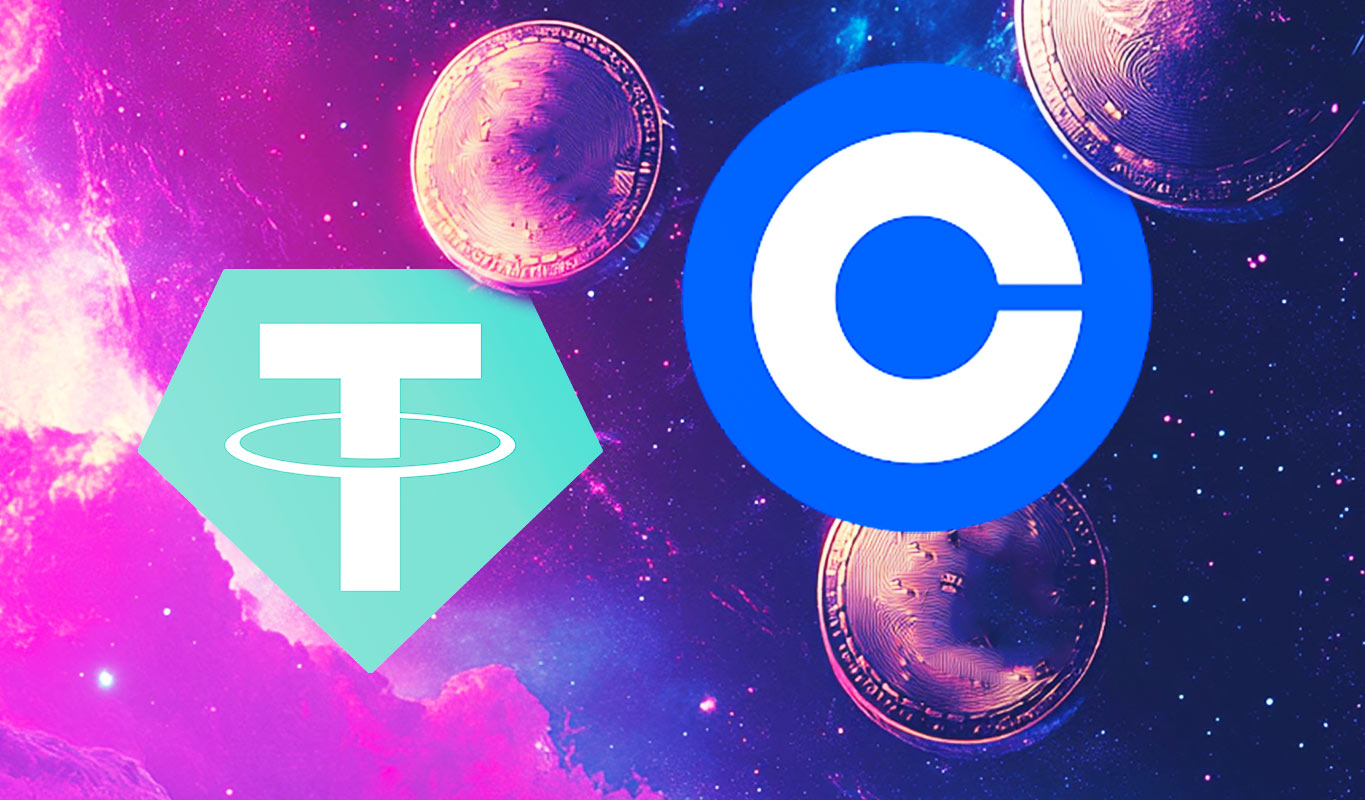



No comments yet